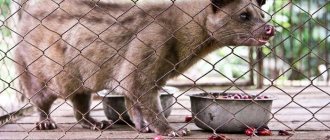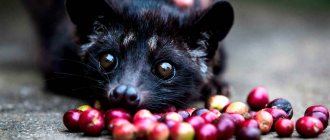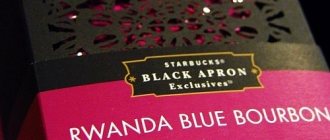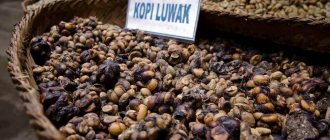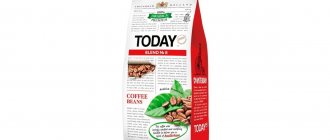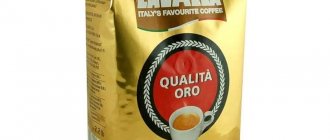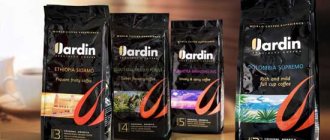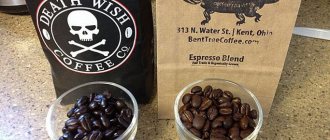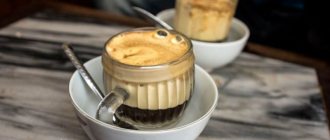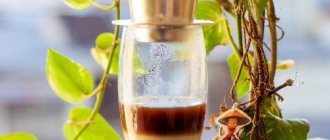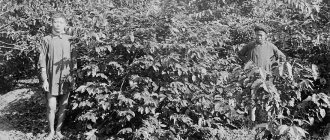Asian Luwak coffee is considered the most expensive due to the difficulty in obtaining the beans and the high quality of the finished drink. The grains must first pass through the digestive tract of palm martens, or musangs. The stomach juice of these mammals eliminates bitterness and contributes to the appearance of a chocolate flavor in the product.
Origin of Luwak coffee.
The Legend of Luwak and the History of the Origin of Coffee
Luwak production began in Sumatra. The colonialists imposed heavy taxes on coffee beans exported from the island. To avoid waste, local residents fed lemur-like animals, civets, with berries.
The grains then had to be washed out of their droppings. The taste of the drink changed. When producers noted this feature, a new variety was born, which quickly became expensive and elite.
According to legend, a peasant from the island of Sumatra was the first to extract grain from excrement. Palm martens, otherwise known as luwak, ate the entire coffee berry crop.
The peasant lived in poverty, so such an incident became a tragedy for him. He, however, noticed that the animals left behind feces in which whole coffee beans were visible. After thinking a little, the man began to remove the coffee from the excrement.
Producer followers
The island of Sumatra is not the only place where Luwak is produced. Suppliers of fermented grains also include Vietnam, the Philippines, and Indonesia. Production takes place in each palm civet habitat.
In Thailand, Black Tusk coffee is produced in a similar way. Instead of musangs, local residents feed the berries to elephants. To obtain a high quality drink, only Thai Arabica is used. The cost of a cup of coffee in some hotels is $50.
Characteristics of the drink
The drink made from grain that has passed through the stomach of an animal is very different from other types of coffee.
Taste characteristics
There is no bitterness characteristic of classic coffee, and there is no sourness either. The taste is soft, creamy chocolate. The drink smells like cocoa and caramel.
Differences from regular Arabica
Due to the peculiarities of obtaining raw materials, Luwak coffee has a lower strength than Arabica coffee. Its taste is less tart and has a greater number of shades. The cost of Luwak is several times higher than the price of Arabica. Because of this, the elite variety of coffee is even called the “drink of the gods.”
Effect on the human body
Thanks to the caffeine contained in coffee, activity increases and a person feels alert. Drinking 1 cup allows you to increase your performance by 10-12%.
Brain activity is stimulated. The weight loss process accelerates. Caffeine helps break down fat cells.
In addition, luwak eliminates cravings for high-calorie foods. The drink strengthens the immune system, prevents the development of inflammatory processes, and increases resistance to infections.
Coffee strengthens the immune system.
Nuances of production in different countries
The coffee production process differs depending on the country.
Indonesia
Indonesian farmers search the area early in the morning, before the sun has yet to warm the ground, to find the freshest wild animal droppings. Immediately after discovery, they contact the buyer, who inspects the excrement and determines whether the grain meets the standards.
Once the coffee arrives at the facility, it is immediately washed and the water is left for analysis to determine whether the feces came from a wild civet or a caged civet.
Vietnam
In Vietnam, the quality of luwak is worse than in Indonesia. Civets on farms are fed not only selected coffee berries. The animals' diet is very different from their natural diet, which affects the taste of the fermented grain.
In addition, under the guise of luwak, they often sell a mixture of coffee that has passed through the digestive system of musangs with robusta and arabica. The concentration of fermented grain can be 1-5% of the total mass.
Feeding animals.
Philippines
The production of luwak is carried out by the inhabitants of the southern part of the Philippines. Animals that eat coffee berries prefer to settle near the mountains. Local residents inspect the forest area every morning to find feces of wild civets.
The number of animals, however, is rapidly declining due to the use of civet produced by martens in perfumery.
Kopi Luwak production on farms
Kopi Luwak or Kopi Luwak, another name for this type of coffee, is produced in very small quantities because the animals feed on more than just coffee beans. Their diet includes large quantities of plants and insects. The annual harvest of real grains (obtained under natural conditions) does not exceed 250 kg, so their price is the highest in the world. She motivated farmers to create special farms where they began to produce coffee on an industrial scale. On such farms, animals are kept in cages, eating selected grains that are not personally chosen by them, but that are offered to them by the owner. According to connoisseurs, luwak beans obtained on farms are inferior in quality to those obtained naturally, even if conscientious owners used selected coffee cherries. However, this type definitely cannot be of poor quality, since for its production the Luwaki use only the best, blemish-free, ripe coffee beans.
Animals that ferment coffee
In addition to musangs, elephants can ferment coffee. The animals' diet includes vegetables, fruits, and sugar cane. Veterinarians ensure that the concentration of caffeine in the blood of animals does not exceed the norm.
Brazilians obtain fermented grains with the help of gray parrots. The birds' diet includes local fruits and nuts. Residents of South America prefer to create conditions close to natural for their parrots, so the taste and smell of coffee from the farm is almost no different from wild coffee.
Fermentation of grains can occur in the digestive system of some species of monkeys. Coffee varieties derived from primates are considered less elite than Luwak.
Varietal varieties
In addition to the classic Copi Luwak, gourmets can try other varieties of the expensive drink.
Black Ivory
Black tusk is processed in the stomachs of elephants. The cost of 1 kg of grain starts at $1,080, and for a cup you will have to pay at least $50.
This variety is not available for sale; it can only be purchased in the Anantara Nature Reserve. Only a few expensive Thai hotels offer the finished drink to guests.
Elite Black Ivory coffee.
Jacques Bird
This Brazilian variety is fermented in the digestive system of Gray parrots. The living conditions of birds on farms are as close to natural as possible; there are no cages.
Freshly roasted coffee is characterized by the aroma of dried black bread with notes of molasses. There is a fruity aftertaste. The price of 1 kg of coffee starts from $430.
Brazilian variety Jacquou Bird.
Coffee Terra Nera
Palm civets are used to produce this variety. Ready, freshly roasted coffee smells of hazelnuts and cocoa. Due to the small volume of production, the cost of the product increases to $1,500 per 1 kg.
The beans are sold only in a single coffee shop in London.
Luxury products are packaged in silver paper with a flap to preserve the aroma. The pack is supplied with a 24-karat gold tag, on which the client’s name can be engraved if desired.
Golden Coffee Terra Nera.
How much does the most expensive coffee cost?
The price of Luwak coffee starts from $600 per 1 kilogram of product. The most expensive and most delicious drink, according to connoisseurs, can be made from Vietnamese grains. 1 kg of such a fermented product costs at least $7 thousand. The price of elite grains is determined by some production features:
- Staff costs are high. Employees need to be paid. Often workers live on farms, which requires food and maintenance costs. The owner is forced to pay for the services of a veterinarian who monitors the health of the animals.
- The owner of the production combines 2 farms in one. The owner is obliged to take care not only of animals, but also of plants.
- The lack of technology in extracting grains from manure slows down the production process. You can get a small portion of the product per day.
- You can give coffee to animals no more than 2-3 times a week. The basis of the animals' diet is soups made from chicken broth with the addition of corn and rice. The civet's stomach is not capable of processing large portions of coffee. Excess grains will not receive the necessary taste and smell.
- The animal chooses the fruits independently. Civets eat only ripe “cherries”. Fruits that animals refuse to eat must be disposed of. This increases costs. On some plantations, animals are invited to choose fruits directly on the branches.
Kopi Luwak coffee obtained from wild animals can be more expensive than beans from farmed animals. This is due to the need to search for excrement. However, drinking such a drink is not always safe for humans. The animal that ate the fruit may have been unwell.
Some farms offer Luwak tasting. A cup of Luwak costs $5. However, many farms cooperate with coffee packaging companies, and visitors may be offered a pre-packaged product.
You can purchase luwak outside the countries of production in specialized stores. The seller must have a license to sell such products. Due to the high risk of counterfeiting, you should not buy the drink online. You should not purchase a product with big discounts, New Year promotions, etc. Genuine Luwak cannot be cheap.
Interesting! Freeze-dried coffee rating: which is better in quality
Rules for preparing the drink
Recipes for making the drink differ depending on the country. Be sure to use purified cold water. Liquid at room temperature is not suitable, since the taste of the drink is not revealed when used. Do not cook luwak in hard tap water, replace it with filtered or bottled water.
With spices
Pour 1 clove star into the cezve, 5 pcs. cardamom, 0.5 tsp. ground ginger. Add 3 tsp. pre-ground coffee beans.
Pour 250 ml of cold water, then place the Turk over low heat. Wait until the foam rises, remove the cezve from the stove. Repeat twice more, then strain the drink.
Coffee with cardamom.
In Turk
Preheat the Turk. Then add 2 tsp. crushed grains, add 1-2 tsp if desired. granulated sugar. Warm the mixture slightly, then add cold water. Cook over low heat until foam rises. Then remove the Turk from the stove and pour the coffee into cups.
Flavored coffee.
In Vietnamese
To make Vietnamese coffee you will need a special filter press. Place the device over the cup, fill 2-3 tsp. ground coffee.
The coffee powder is compacted and then poured with a portion of water. After 0.5 minutes, add a little more liquid. Then they wait until the water has completely flowed into the cup and drink immediately. To get warm coffee, it is recommended to first place the mug in a container of hot water.
Vietnamese coffee.
Criterias of choice
When choosing grains, consider a number of criteria:
- There should be no glossy shine. This feature indicates roasting using palm oil. Sometimes shine occurs due to too rapid heat treatment. This is beneficial for the manufacturer because it saves time. The taste of the product, however, deteriorates.
- Take a closer look at the grains. The packaging must not be broken or damaged. If the grains of one blend differ in size, it is better to refrain from purchasing.
- A price that is too low indicates a fake. Luwak coffee costs from $200 per 100 g; it is not profitable for the manufacturer to sell the product cheaper.
- Flavorings are not allowed. Their use indicates low grain quality.
The natural process for producing unusual beans
It was natural for humans to be interested in Luwak grains as ordinary cute animals make them.
- Luwakis love to feast on selected coffee cherries, which are fermented in their stomach with the help of gastric juice and the substance civet, which neutralizes acids and bitterness.
- The coffee beans are peeled inside the animal to remove the skin and pulp surrounding the bean and come out as finished beans. The taste becomes special due to barely perceptible bitterness and acidity, making the drink incomparable in taste even with very expensive varieties of coffee.
- After washing and roasting, the grains are ready for use.
The color of the grains has a beautiful caramel shade. Fans of this drink also note the presence of notes of honey, nougat, butter and a long, pleasant aftertaste. It is recommended to drink Luwak coffee without any additives to enjoy its special taste. When ice is added, it acquires an unusual aroma, which does not happen with other types of coffee beans.
What causes the high cost of Luwak coffee?
The cost of production is high for 3 reasons:
- Small production volume. The mass of grains in the feces of the palm marten is small. Making “wild” coffee is further complicated by the need to search for excrement in the forests where the musangs live.
- Palm civets produce civetin, a substance necessary for processing grains in the digestive tract, for only 6 months of the year. At other times, the farms are idle and no drink is produced. Often animals are released into the wild during this period so as not to spend money on their maintenance.
- Musangs do not breed in captivity, so farmers have to regularly catch new individuals in the forests.
Musangs do not have offspring in captivity.
WHAT IS THIS BEAST, CIVETTA?
The genus of civets, or civets, is part of the civet family. These are carnivorous mammals that live in the tropical regions of Africa, southeast and southern Asia. In countries where English is spoken, these animals are called civets , in all others - civets or civets . There are 35 species included in 15 genera from the viverridae family. The most famous of them belong to the genera of civets: Owston's civet, otter civet, Kalimantan civet, striped civet, three-striped civet, Sulawesi civet, Himalayan civet, African civet, small civet, musang. Different species of civets have different body sizes. The smallest are the small civet, palm civet, three-lined civet - 45-55 cm body length, 1.7-2.5 kg in weight. Large civet species reach 80 cm in length and 7-9 kg body weight. The tails of different species of civets are of different lengths: some are almost the same as the body length, some are shorter. Almost all types of civets, in addition to small species of living creatures (birds, squirrels, rats, amphibians, worms, beetles, crustaceans, etc.), also feed on fruits, fruits, nuts, and roots. Civets are nocturnal animals. Only during the mating season are they active during daylight hours. Their main location is trees. Civets are the best of all predatory animals to move through trees, almost like squirrels. Many species of civets make nests in hollows. But some inhabit caves, burrows and human buildings (barns, stables). Some species of civets give birth once a year, and some - twice. They usually have 2-3 cubs per litter, some species have up to 5 cubs. The female feeds them with milk for a year. The lifespan of viverrids ranges from 5-7 years to 15 years in the wild. In captivity, some animals lived up to 25 years.
photo: Civets
Interesting Facts
The legend about the origin of this type of coffee is funny and educational, but there are many more interesting facts about this extraordinary drink:
- Kopi Luwak is often criticized by environmentalists. Coffee berries are not the basis of the diet of martens; excess caffeine has a negative effect on the animal’s body. In addition, on farms the animal is often kept in poor conditions.
- In captivity, the musang eats approximately 1 kg of berries daily. A daily portion of excrement contains no more than 60-70 g of grains.
- Every year, only about 300 kg of Kopi Luwak enters the world market. Most lovers of expensive coffee are in the UK, Hong Kong, and Japan.
- In Vietnam, luwak is traditionally served over ice. If desired, condensed milk can be added to the drink. Additionally, a cup of green tea is served.
What kind of coffee is in Vietnam?
In addition to the fact that there is a lot of coffee here, it is roasted in unusual ways (for example, with sweet syrups), thanks to which it acquires a unique sweet-chocolate taste. And they serve coffee in any cafe: thick and aromatic, with ice and an additional glass of delicious green tea. Coffee is the most popular drink in Vietnam.
Ordinary Vietnamese coffee shop: price for a glass of coffee - 12,000 dong ($0.5), green tea with ice - free
Ice coffee with condensed milk: an unforgettable taste!
Vietnam has two varieties of beans: Robusta and Arabica . Robusta is much more popular; you can often find blends based on Robusta with a small addition of Arabica. In Nha Trang, you can find many shops on the street where the coffee beans you choose will be ground right in front of you and sealed in a bag - in my opinion, a great gift for family and friends!
There are a great variety of such stores: you choose beans (you can mix varieties in any proportions), and they grind and seal them right in front of you
The most popular brand of coffee in Vietnam can be called Me Trang (read as Mechang). Shops of this company can be found on every corner in tourist Nha Trang. Mechang coffee is really tasty, but we didn’t notice much difference compared to little-known brands of coffee from the Vietnamese market.
The most famous coffee brand in Vietnam today is Me Trang
In addition to Robusta and Arabica, the type of coffee known as Luwak (or Luwak) is also found everywhere in Vietnam. These are ordinary coffee beans that have passed through the gastrointestinal tract of one very cute fur-bearing animal.
What is this super trendy Luwak coffee made from animal feces in Vietnam? What does it smell like, and most importantly, how did people get there?
